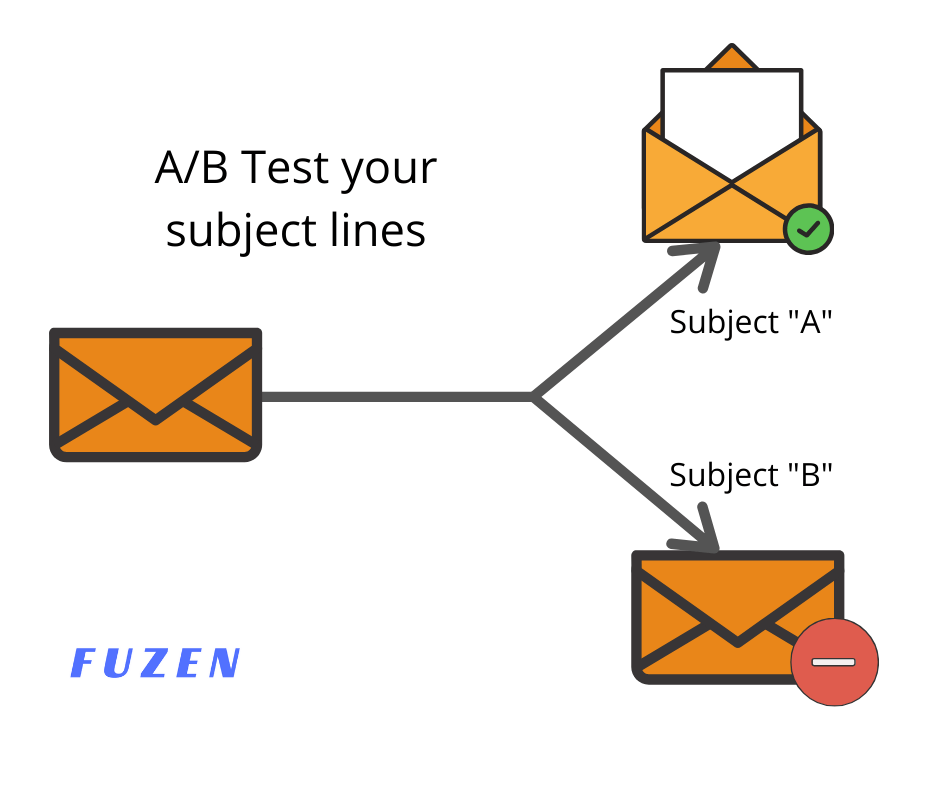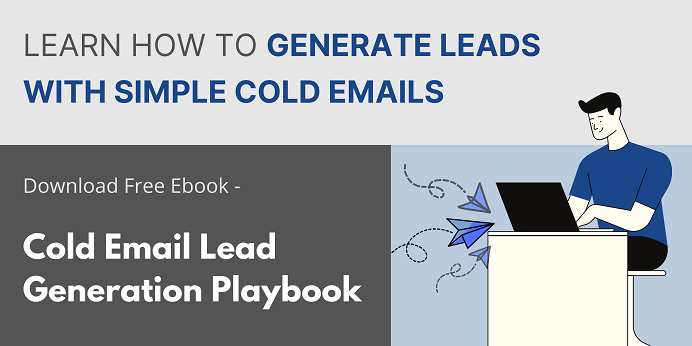Email is still a very handy and effective channel for marketing and sales. It’s largely free, anyone can do with a creative enough email copy.
But that brings us to the downside of email marketing. Because it’s so easy and inexpensive to do it, everyone does it. So there’s a lot of noise and it takes a good bit of creativity to stand out from this noise. If you write any cold emails, you know how difficult it is to get people to read them and actually respond to them.
At Fuzen, we send a lot of cold emails and we even help other businesses with our cold email automation app built within Google Drive. So based on our own experiences, we have compiled a list of cold email marketing tips, to help you improve the success rate of your cold email campaigns.
Table of content
1. Always test your subject lines
2. Keep your emails short and straight
3. Highlight experience, build trust
4. Build familiarity
5. Focus on value, not on features
6. Don’t use click bait subject lines
7. Clear ‘call to action’
8. Automate the actual email sending
9. Warm up email account and test deliverability
Always test your subject lines
You can write a very effective email, listing powerful features of your product, names of your biggest customers and their testimonials. But it will be completely useless if it doesn’t get opened.
That’s why the subject line to your cold email is as important as your email text (if not more).
When you write a cold email, the recipient doesn’t know your name, maybe not even your company. So the subject line is your only fighting chance to get his attention and get him to click on it.
Now you can imaging why it is so important and often very difficult to write an eye catching subject line.
But there is a solution. You can always experiment with different types of subject lines, try different approaches and see what sticks.

That’s why it is important to A/B test a bunch of subject lines before you can find something that works for your audience.
Here are some tips for good cold email subject lines –
- Ask a question to invoke curiosity. For example – “Do you know which marketing strategies work best during holidays?”
- If possible, establish familiarity. Make it easier for them to recognize and trust you. The best way to do this is to use industry specific references. Give them an impression that you are also an insider.
- Use big data points, if you have them. If you have helped a big brand achieve meaningful success, mention that to get their attention. For example – “How we helped #CompanyName# to grow 50% in six months”
- Or you can try a completely different approach, by just saying “Hi”. It can be a surprisingly effective way to get your emails opened. But you’ll never know until you have tested it.
Keep your emails short and straight
When you write a cold email, the recipient doesn’t know you. So even if you write a strong subject line and get them to click on it, they only give you a few seconds to make your case.
That’s why it is important to get straight to the point. A general rule of thumb that we follow at Fuzen, is to keep the email text between 5-10 lines.
Any longer than that and your audience will be intimidated even before reading your email. Remember, they have (subconsciously) allocated only a few seconds to your email. If they see a long email that can’t be read in a few seconds, they will ignore the whole thing altogether.
Highlight experience, build trust
If you managed to get your audience to open your emails and read them, you have got their attention. Now is the time to tell them about your products and services.
You can tell them many nice things about how you can help them with their business, but they will not readily take your word on it. Because, remember this is a cold email and they don’t yet trust you.
So focus on building an element of trust with whatever ammunition you have. If you can tell them about your existing customers, how you have helped them and the nice things they are saying about you, it will help you to start building some trust with the recipient.
Here are some things that you can highlight –
- Number of years in the business
- Total number of customers or users
- Big achievements or iconic projects
- Testimonials or references for marquee customers
Mention just one of these key data points. Don’t go overboard by writing a long list. Remember the 5-10 lines rule. Ultimately, your recipients are not interested in knowing all your customers. It will suffice to give them 2 names that they can recognize.
Build familiarity
But most new businesses don’t have any big brand customers to mention. So what do you do if you’re just getting started?
The next best thing to trust is building familiarity.
Even if you’re a new business and don’t have a long list of customers, you can still show off your knowledge of the target industry. That will tell your audience that you are also an insider just like them. This familiarity will also help similarly to the trust factor.
Here are some things that you can mention –
- If you have any mutual connections from the same industry, mention them
- If the recipient has been in news recently, mention how you read about it, how you follow their business and use that thread to initiate a conversation
- Start a conversation about industry specific event, publications, statistics etc. But be careful that these references should be relevant to your products and services.
Focus on value, not on features
If you have followed these cold email marketing tips so far, you’ve succeeded in getting your email opened and building a small degree of trust or familiarity.
Now let’s get to the sales pitch.
Some marketers have a habit of throwing a well articulated feature list at everything, even in their cold emails.
But when it’s a cold email, the recipient has not asked about your product features (not an inbound lead). They don’t even know that they need your product!
So your first job is to convince them that you product can benefit them and maybe they really need it. Writing about the possible use cases and benefits will help much more than talking about the features in regular marketing jargon.
Your email should teach them about the possible benefits. Give them a solution to their problems, rather than advertising your product.
Don’t use click bait subject lines
We already talked about how important subject lines are for cold email campaigns, but also how difficult it can be at times to write a compelling subject line.
Sometimes that difficulty makes you think about ‘click bait’ subject lines. And if you only focus on email opening rates, it seems like these click baits really work well.
But if you look at the conversion rates of your cold emails into warm leads, you will realize how ineffective the click baits are.
Click bait subject lines over-promise and under-deliver. So many of your recipients will open the emails with great expectations. But they will end up with disappointment, when they realize the subject line was either a tall promise or something else entirely unrelated to the what your email says.
This disappointment will kill whatever trust factor you have built up and they will start ignoring your future emails.
Therefore, avoid click baits at all times.
Clear ‘call to action’
When you have followed all of these cold email marketing tips, you’ll be able convince your recipients about the value of your products and services or at least make them curious about it.
So while you have their attention, ask them to take a meaningful action to indicate their interest in what you’re selling. Make a clear call to action.
Without a clearly stated call to action, customer can go on about his day and forget about your little email in 1-2 days. So without a call to action, you risk losing all the hard work invested in your cold email.
What action you should ask for depends on a variety of factors like brand recognition, trust factor, average selling price, purchase decision making cycle.
For simpler, cheaper products you can directly give them a link to your online store.
But for more complex and expensive solutions, purchase decision will be made by multiple stakeholders, discussions will take a few weeks. So you can ask your recipients to take the first step in this long sales cycle – ask for a demo or a meeting or even a phone call.
But in any case, make a clear call to action.
Automate the actual email sending
Those are all the important tips for a successful cold email marketing campaign. You can write these cold emails and send them manually or you can even automate them when you wish to scale up your marketing outreach. These cold email marketing best practices will help you scale up your cold email outreach, while ensuring all your cold emails are able to reach INBOX.
When to send manual cold emails
- When you are exploring and experimenting with different subject lines or cold email text or CTAs
- When you have a very small mailing list with just 100-200 recipients
- When you are selling high value, complex solutions. That’s when you need to highly personalize your cold email to get the attention of C-level decision makers
When to automate your cold emails
- When you have a well established email marketing process and formats
- When you want to send thousands of cold emails or marketing emails
- When you are able to personalize your emails with automation tools
At Fuzen, we provide mail merge tool connected to Google Drive and Gmail which can be used to send scheduled mail merge campaigns. A mail merge workflow combines recipient data from a spreadsheet, with email template documents to create highly personalized emails.
In effect this will enable you to send highly personalized cold email campaigns, with high email deliverability (thanks to scheduling).
Check it out for free. It can be easily customized to fit it to your specific marketing process.
Warm up email account and test deliverability
When you want to send cold emails at scale, with or without automation, you will need to first warm up your email account. If you send a few thousand cold emails in the very first week from a new email account, there are very strong chances of your emails landing in SPAM.
Spam filters look at the history of your email account when deciding whether or not to classify your emails are spam. If you only have outgoing email traffic, if majority of your emails are identical and if many people just ignore your cold emails, then there’s a high chance you are spamming them. So spam filters will put your subsequent emails in the SPAM folder.
To avoid this, you will need to first warm up your email account by –
- Subscribing to a bunch of newsletters to get incoming email traffic
- Send a small number of emails initially, gradually increasing the daily number of 4-6 weeks
- Start by having meaningful email exchanges with people you know, to establish some credible email usage history.
After a successful warm up, you should also test the deliverability of your emails before starting any cold email automation campaigns.

